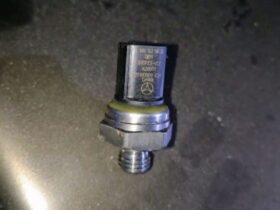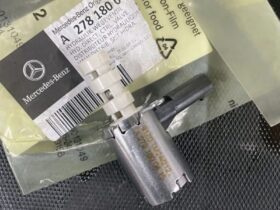Table of Contents
Engine Misfire and Engine Light On: A Case Study on Mercedes-Benz G Class W463 with the M177 Engine
In this article, we’ll delve into a common yet troubling issue many Mercedes-Benz G Class W463 owners equipped with M177 Engine might face: Engine Misfire and Engine Light On. We will walk through a detailed case study to understand the symptoms, diagnostic process, and resolution. Whether you’re an enthusiast, a technician, or a G-Class owner, this article aims to provide valuable insights into addressing such issues effectively.
Vehicle Overview:
- Model: Mercedes-Benz G Class W463
- Engine: M177
- Customer Complaint: Engine Misfire and Engine Light On

Customer Complaint
The vehicle was brought in with a noticeable engine misfire and an illuminated engine light. The owner reported rough idling and reduced engine performance, which raised concerns about the underlying cause of these symptoms.
Initial Diagnostic Steps
A short test was performed using the diagnostic tool, revealing stored faults in the ME (Motor Electronics) control unit. The faults indicated an engine misfire in cylinders 1, 2, 3, and 4, along with a “Mixture Too Rich” condition for cylinder bank one at idle speed. This data suggested a potentially complex issue that required further investigation.

Step-by-Step Diagnostic Process
- Checking Actual Values & Self-Adjustment in Idle Speed:
The first step was to examine the actual values and self-adjustment data at idle speed. These parameters were essential in identifying any irregularities in engine performance and fuel management. - Fuel High-Pressure Circuit & Pressure Sensors:
Next, the fuel high-pressure circuit and associated pressure sensors were checked. Both are critical for ensuring that the engine receives the correct amount of fuel at the right pressure. Any deviation could result in a misfire. - Injector Performance Data:
The injector performance data was analyzed to rule out issues with fuel delivery. Smooth running values were also checked, which indicated how evenly the engine was operating across all cylinders. - Fault Counter & Fuel Pump Actual Values:
The fault counter and fuel pump actual values were reviewed to ensure that the fuel system was operating within specified parameters. - Pressure Tests:
Comprehensive pressure tests were conducted to identify any leaks or inconsistencies in the fuel delivery system. However, all components were found to be within the specified value range.

Software Updates
After the initial diagnostics, it was essential to check for any software updates for the ME and FSCU (Fuel System Control Unit) control units. No updates were available, confirming that the issue was likely hardware-related rather than a software glitch.
Further Investigation – Emission System
- Fuel Emission System Lines & Charcoal Canister:
The fuel emission system, including lines and the charcoal canister, was inspected for any physical damage or blockages. The charcoal canister plays a vital role in trapping fuel vapors and preventing them from being released into the atmosphere. No damage or abnormalities were found. - Purge Valves:
The purge valves, which are responsible for controlling the flow of fuel vapors from the charcoal canister to the engine, were also checked. It was discovered that the right bank purge valve was stuck in the open position. This malfunction could lead to an excessive flow of fuel vapors into the engine, causing a rich mixture and potentially triggering an engine misfire.

Resolution
The faulty right bank purge valve was replaced, and the vehicle was retested. After the replacement, the engine misfire issue was resolved, and the engine light was no longer illuminated. The vehicle’s performance returned to normal, and no further faults were detected.
Engine Misfire and Engine Light On is a significant issue that can affect the performance and drivability of the Mercedes-Benz G Class W463. In this case, a thorough diagnostic process led to the discovery of a faulty purge valve, which was the root cause of the problem. This case study highlights the importance of systematic diagnostics and the need to consider all possible causes, including the often-overlooked emission system components.
Engine light on and off
The engine light on and off scenario is a situation where the check engine light on a vehicle’s dashboard intermittently illuminates and then turns off. This can be confusing and concerning for vehicle owners, as it suggests that there might be an underlying issue with the vehicle that comes and goes. Here’s some information to help you understand what might be happening:
Common Causes of Intermittent Check Engine Light:
Loose or Faulty Gas Cap:
- A loose or damaged gas cap is one of the most common and easily fixable reasons for the check engine light to turn on. If the gas cap isn’t sealed properly, it can cause a pressure imbalance in the fuel system, triggering the light. Once the cap is tightened or replaced, the light might turn off after a few drives.
Minor Sensor Issues:
- Various sensors in the engine, such as the oxygen sensor or mass airflow sensor, might momentarily give incorrect readings due to temporary conditions, like sudden changes in temperature or humidity. This can cause the engine light to flicker on and off.
Temporary Fluctuations in Engine Conditions:
- The engine control unit (ECU) continuously monitors the engine’s performance. Sometimes, a minor fluctuation in engine conditions (like a misfire that doesn’t repeat) can trigger the light. If the condition corrects itself, the light may turn off.
Intermittent Electrical Issues:
- Electrical problems, such as a loose connection or a failing component like the alternator or battery, can cause the check engine light to come on and off as the issue comes and goes.
Emissions System Problems:
- Issues with the emissions system, such as a failing catalytic converter or EGR valve, might cause the light to turn on intermittently. These problems can sometimes be sporadic, especially if the issue is just starting.
Faulty Spark Plugs or Ignition Coils:
- Worn-out spark plugs or ignition coils can cause misfires, which might trigger the engine light. If the issue is inconsistent, the light may turn off after the misfire stops.
What to Do When the Engine Light Turns On and Off:
Check the Gas Cap:
- Start by checking your gas cap to ensure it’s properly tightened. If it’s loose, tighten it and see if the light stays off.
Monitor Driving Conditions:
- Pay attention to when the light comes on. Does it happen during specific conditions, like when the engine is cold or when accelerating? This information can help diagnose the issue.
Get a Diagnostic Scan:
- Even if the light turns off, it’s a good idea to have your vehicle scanned with an OBD-II reader. The ECU may have stored a trouble code that can provide insight into the problem.
Don’t Ignore It:
- While the light may turn off, the underlying issue could still be present. If the light comes on repeatedly, it’s a sign that something needs attention. Getting it checked by a professional can prevent more severe problems later on.
Conclusion:
The “engine light on and off” situation can be a sign of minor issues or the start of something more serious. While it might seem like the problem is resolved when the light turns off, it’s essential to investigate the cause to ensure your vehicle remains in good working condition.









Leave a Reply